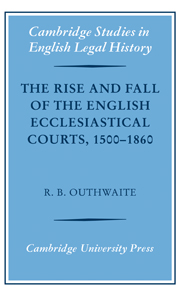Book contents
- Frontmatter
- Contents
- Foreword by R. H. Helmholz
- Preface
- Table of parliamentary statutes
- List of abbreviations
- 1 The ecclesiastical courts: structures and procedures
- 2 The business of the courts, 1500–1640
- 3 Tithe causes
- 4 Wills and testamentary causes
- 5 Defamation suits
- 6 Marital suits and marriage licences
- 7 Office causes
- 8 The roots of expansion and critical voices
- 9 Charting decline, 1640–1830
- 10 Explaining decline
- 11 The bills of 1733–1734
- 12 Snips and repairs: small steps to reform, 1753–1813
- 13 Royal commissions and early fruits, 1815–1832
- 14 Reform frustrated
- 15 Reforms thick and fast, 1854–1860
- Select bibliography
- Index
4 - Wills and testamentary causes
Published online by Cambridge University Press: 21 January 2010
- Frontmatter
- Contents
- Foreword by R. H. Helmholz
- Preface
- Table of parliamentary statutes
- List of abbreviations
- 1 The ecclesiastical courts: structures and procedures
- 2 The business of the courts, 1500–1640
- 3 Tithe causes
- 4 Wills and testamentary causes
- 5 Defamation suits
- 6 Marital suits and marriage licences
- 7 Office causes
- 8 The roots of expansion and critical voices
- 9 Charting decline, 1640–1830
- 10 Explaining decline
- 11 The bills of 1733–1734
- 12 Snips and repairs: small steps to reform, 1753–1813
- 13 Royal commissions and early fruits, 1815–1832
- 14 Reform frustrated
- 15 Reforms thick and fast, 1854–1860
- Select bibliography
- Index
Summary
The second plank sustaining the instance side of the business of the ecclesiastical courts was the testamentary cause, most often a wrangle between individuals over the details of wills and testaments. The will was the document by which people disposed of their assets at their death. In the Middle Ages the will and the testament were assumed to be separate instruments – a fact that finds recognition in later writings. ‘Testament and will’, wrote Burn in the eighteenth century, ‘strictly speaking, are not synonymous.’ ‘A will’, he continued, ‘is properly limited to land; and a testament only to chattels.’ The will, therefore, dealt with the disposal of real property – land; the testament with the disposal of chattels or personal property – household effects, working tools and equipment, livestock, cash and credits. By the mid-sixteenth century the two instruments are usually conjoined in one – the last will and testament. Burn recognised this, writing that usually ‘the words will and testament are used indiscriminately’.
Although, as Helmholz has demonstrated, the church courts lost litigation over debts owed by and due to the deceased early in the sixteenth century, other testamentary causes rose in marked fashion in many ecclesiastical courts in the later sixteenth and early seventeenth centuries, despite the fact that, as with tithe cases, the common law and equity courts were also dealing with such matters. Chancery, for example, encroached on the spiritual courts in respect of trusts, legacies and debts in wills.
- Type
- Chapter
- Information
- Publisher: Cambridge University PressPrint publication year: 2007



